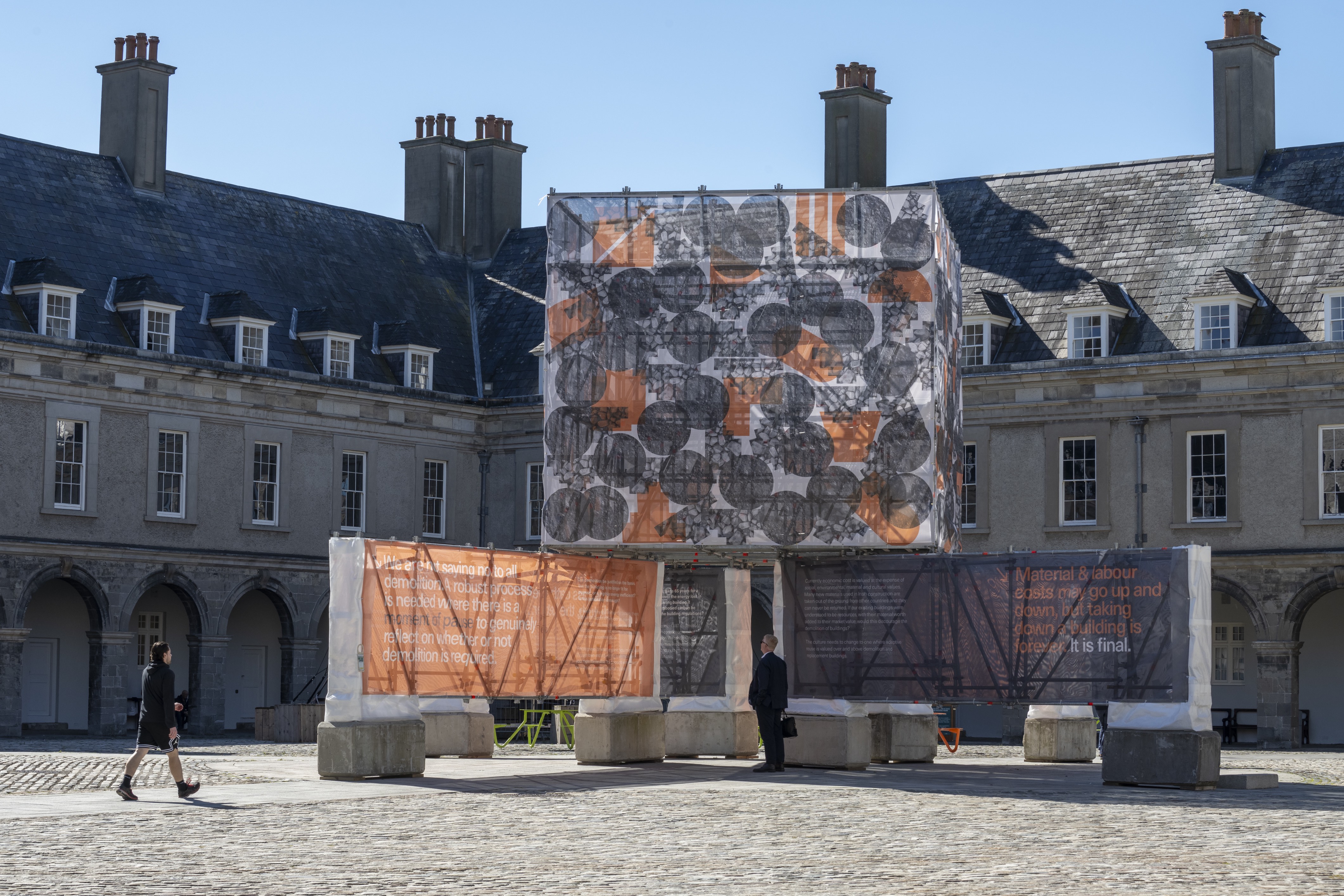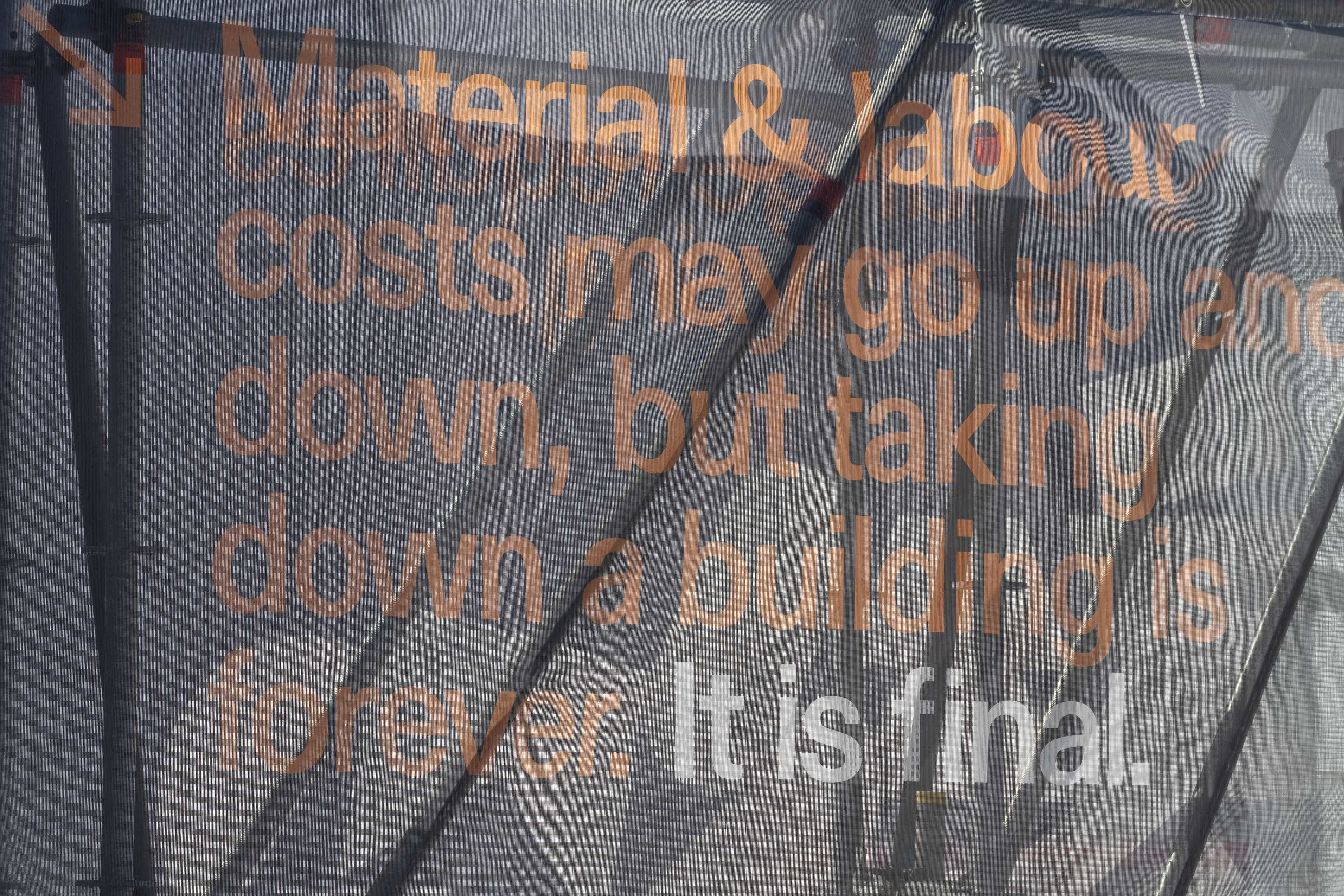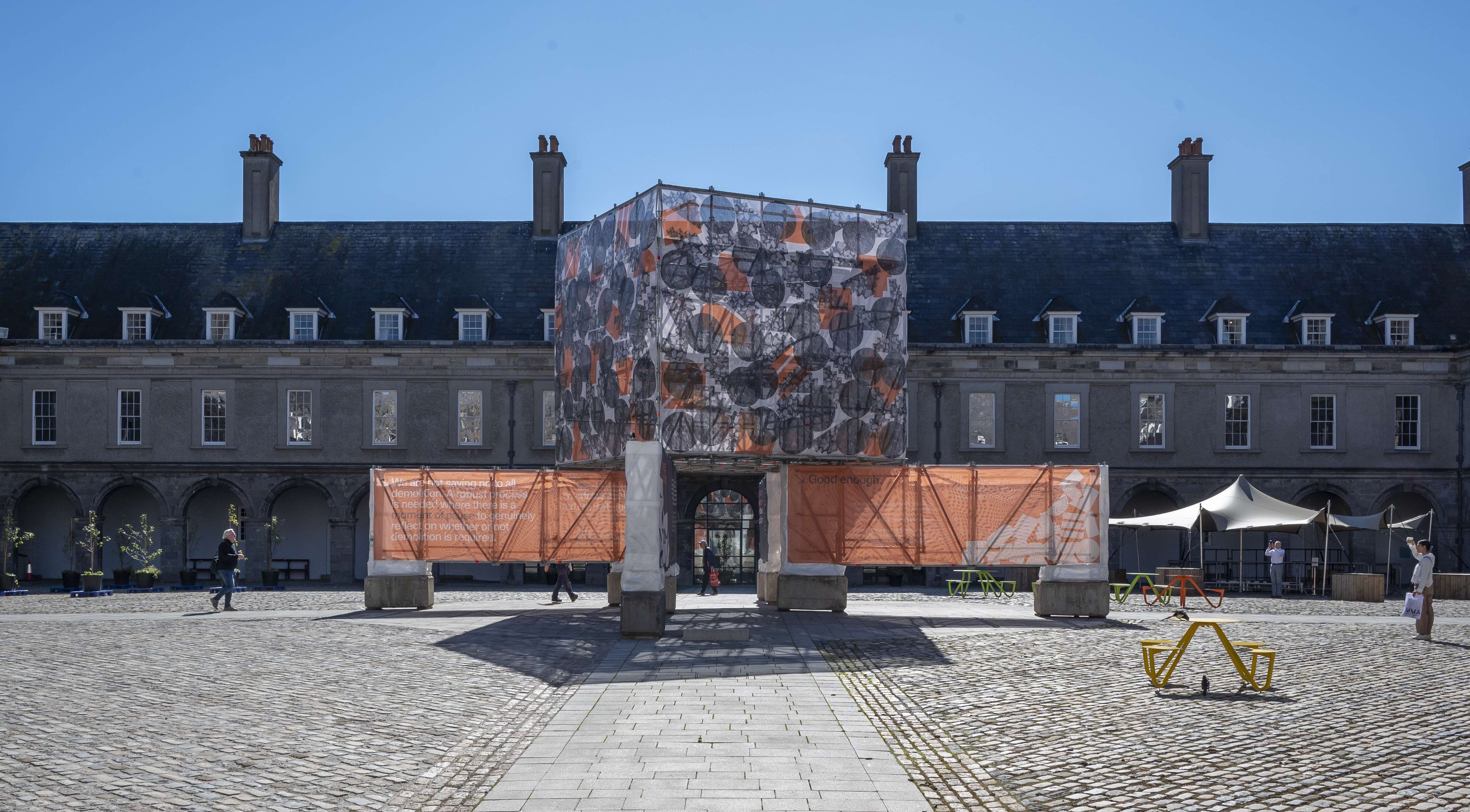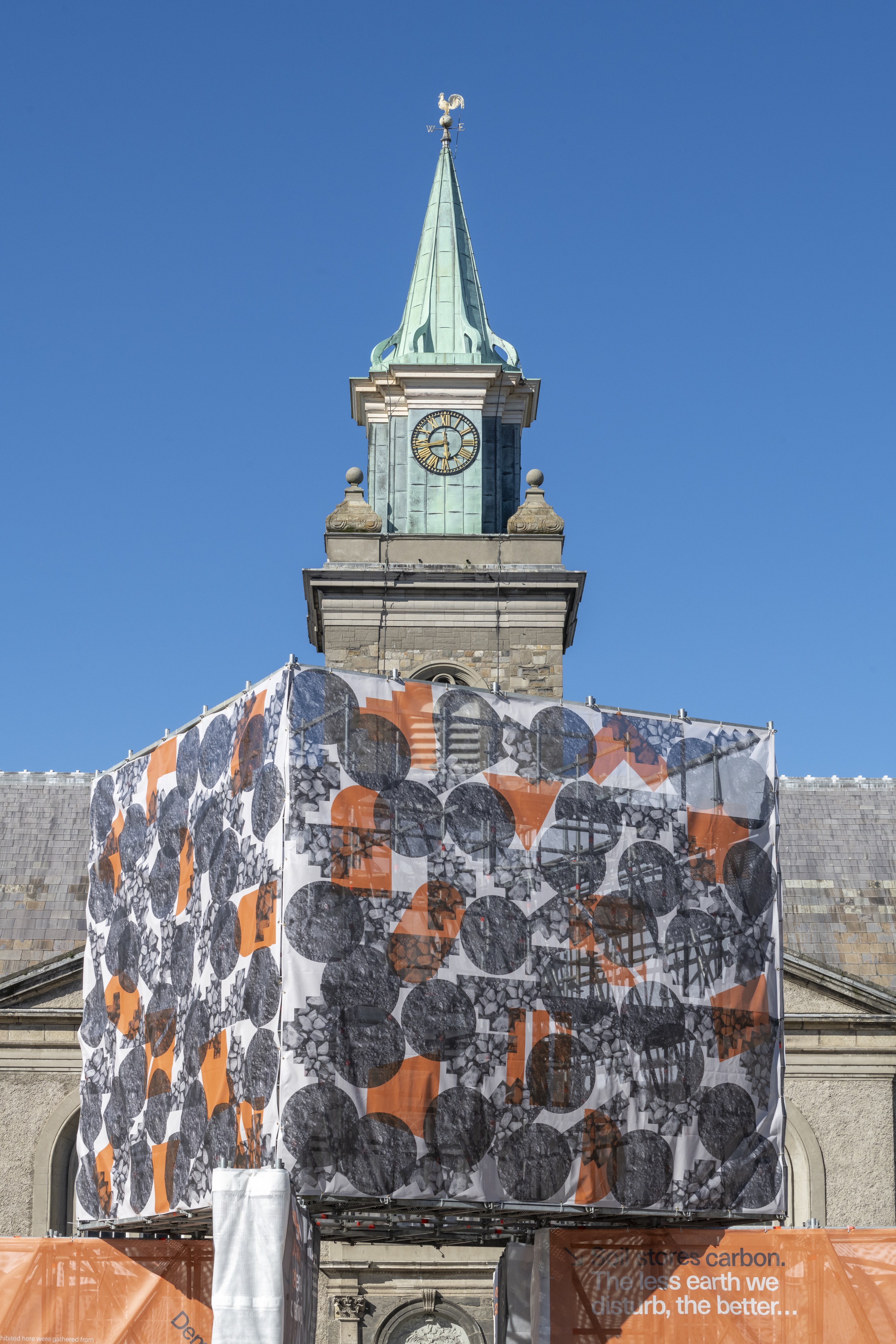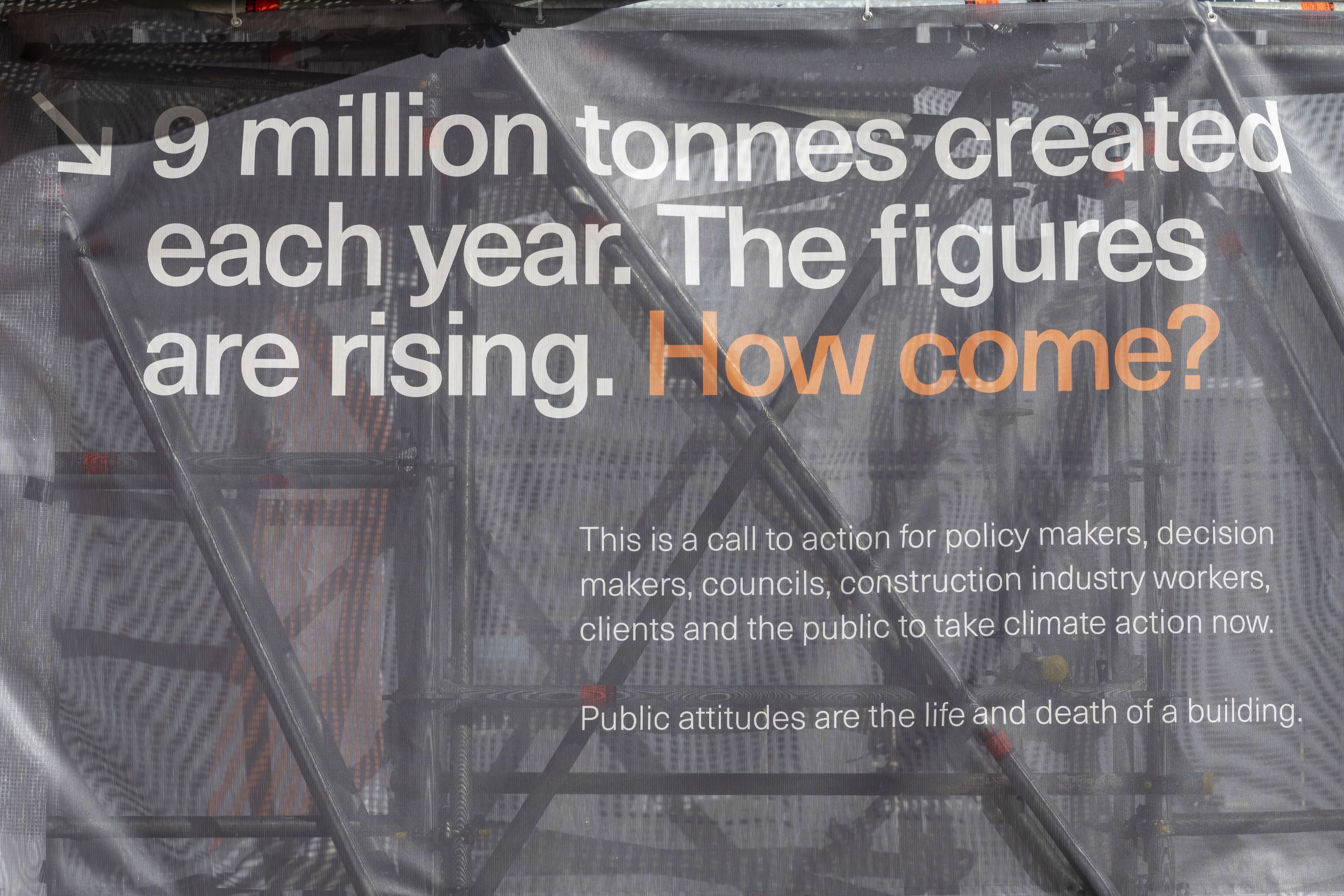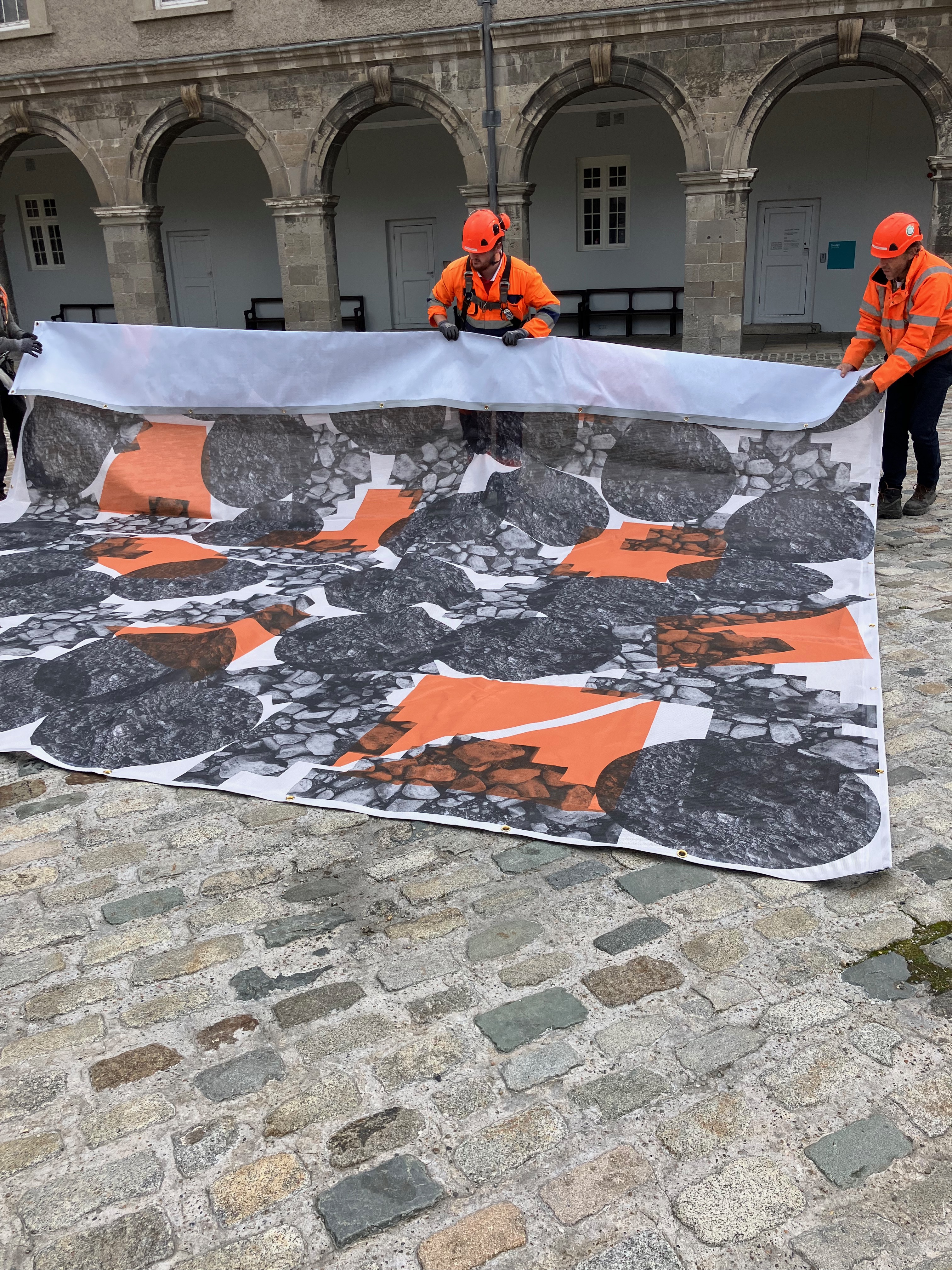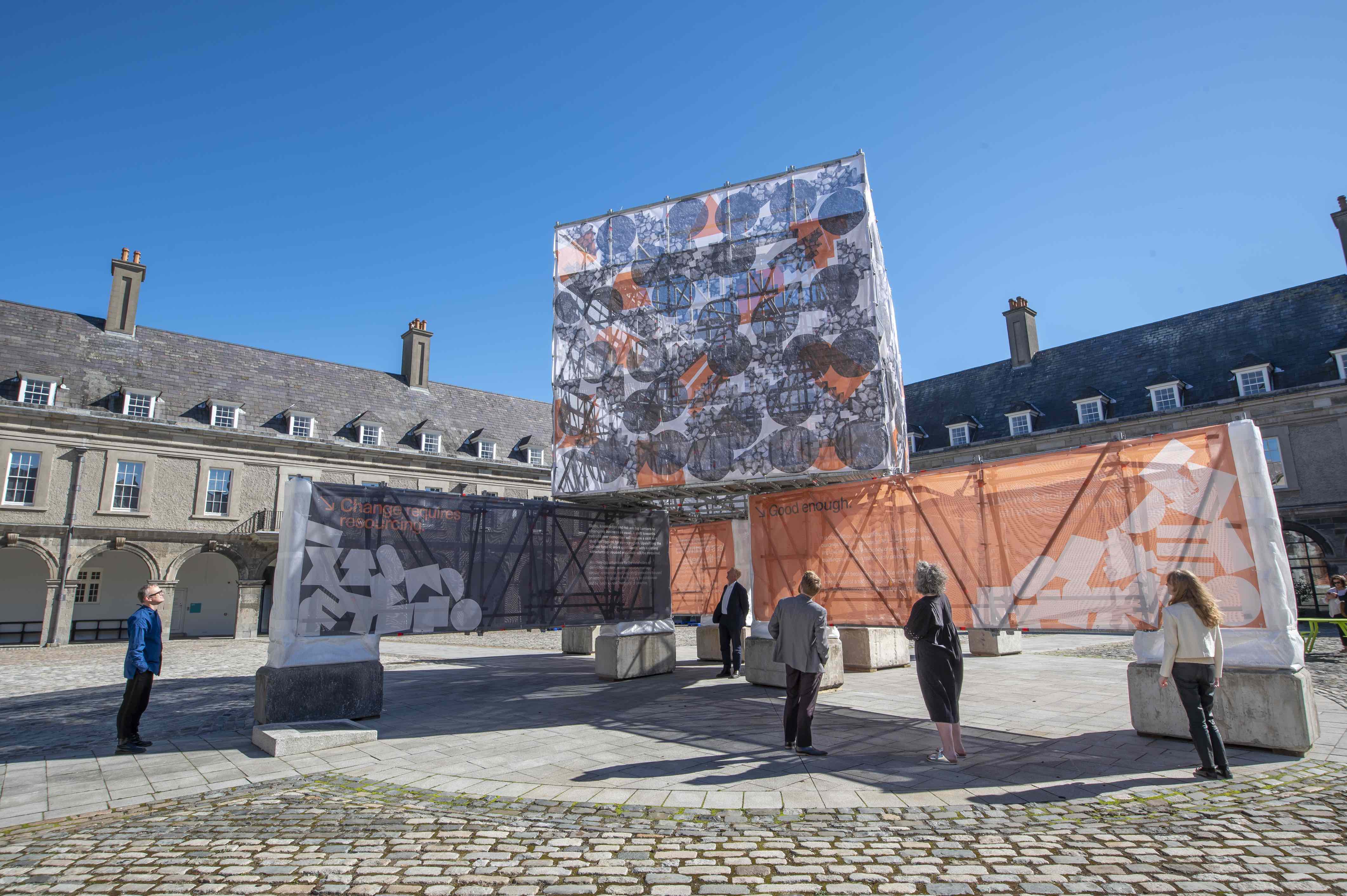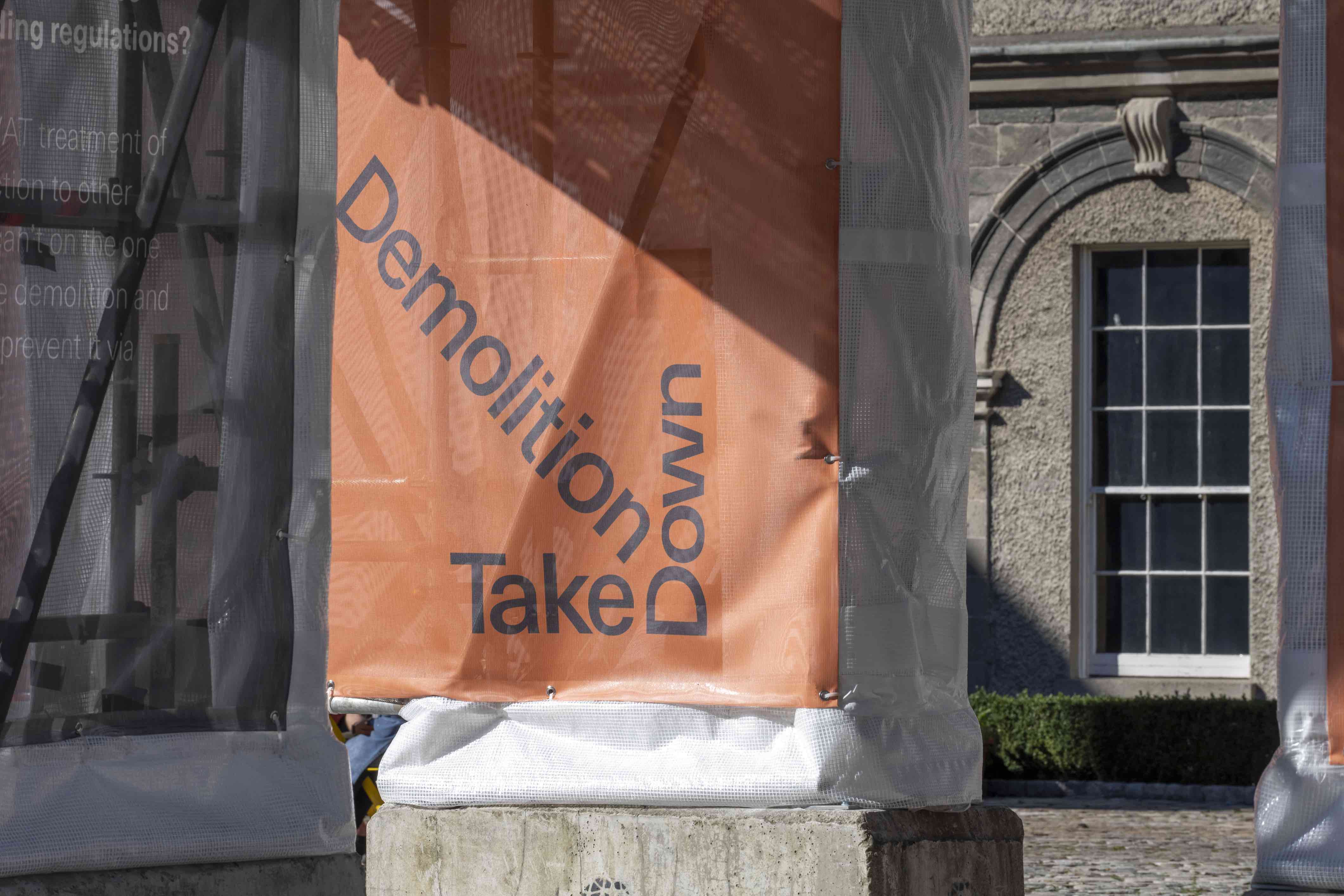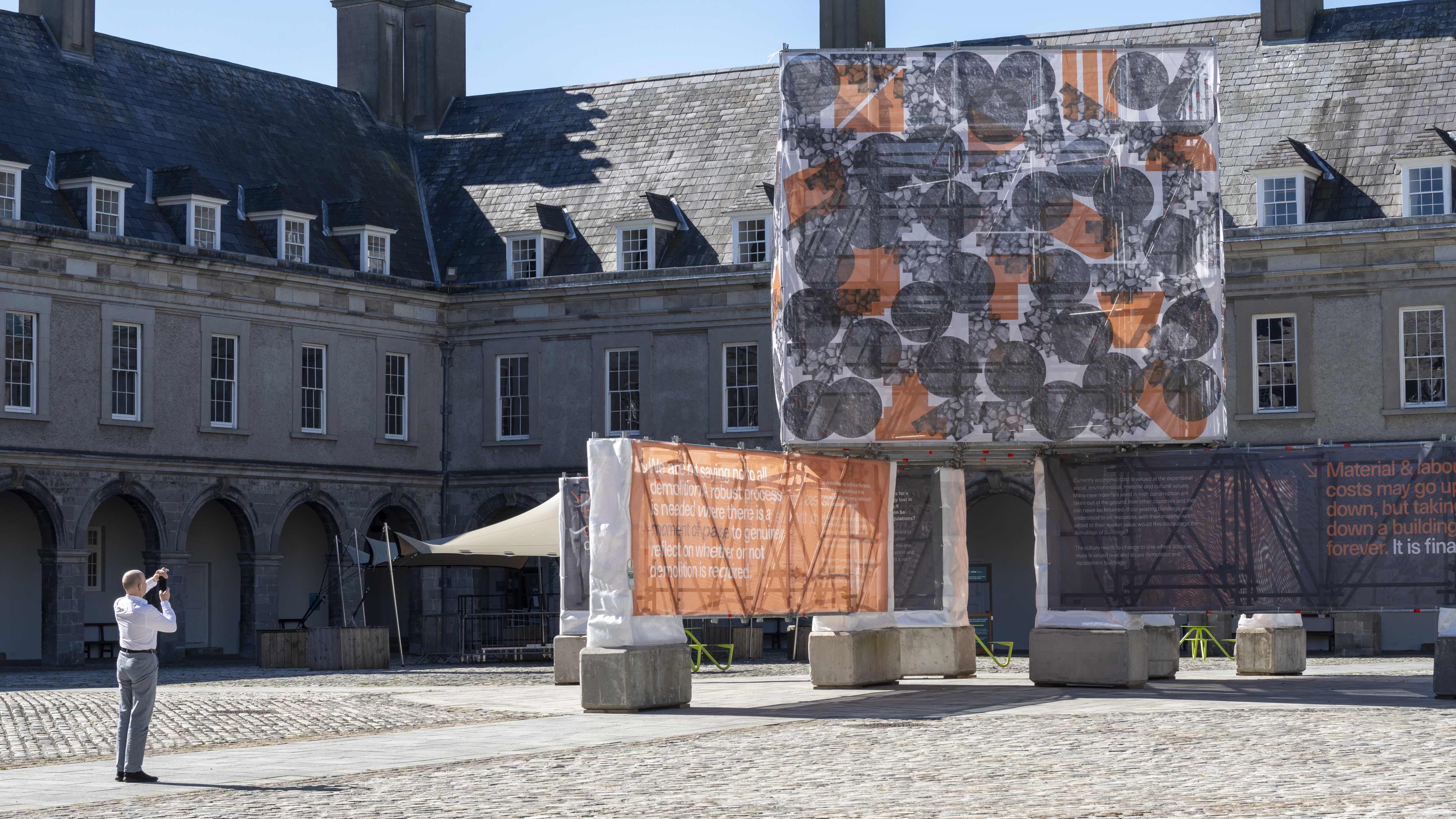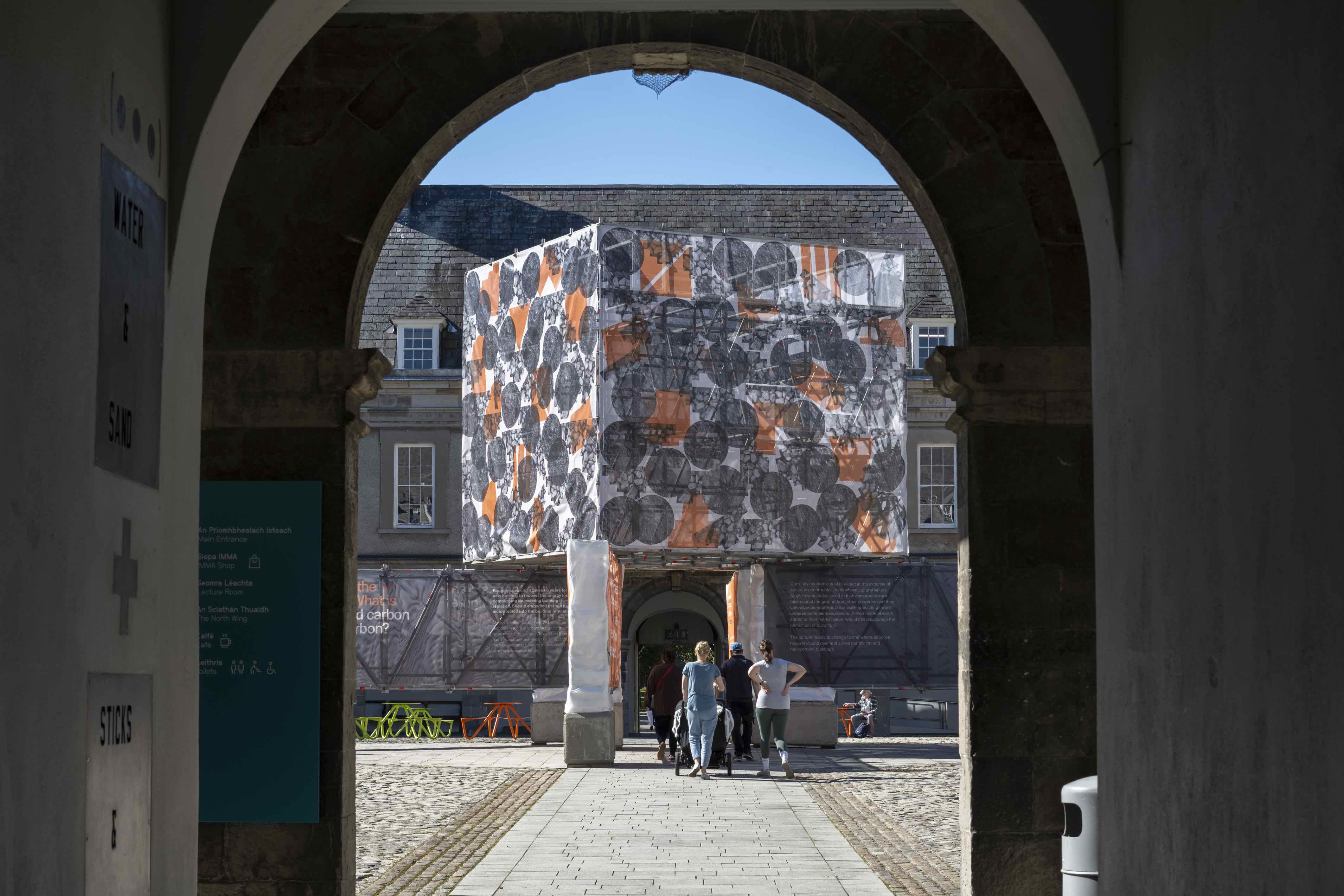Shaping a circular industrial ecosystem and supporting life-cycle thinking
Demolition Take Down
Demolition Take Down: research & engagement initiative
The Irish construction industry accounts for 6% of the employed population but generates 48% of all waste produced in Ireland. Demolition Take Down is a research and engagement led by Islander Architects. Through explorative research and cross-disciplinary conversations, we aimed to shift attitudes and behaviours within the construction industry. We sparked a nationwide discussion and pave the way for more sustainable, responsible approaches to demolition in Ireland.
Ireland
National
Mainly urban
It refers to other types of transformations (soft investment)
Yes
2024-11-30
No
No
No
As an individual partnership with other persons/organisation(s)
Demolition Take Down, a research and engagement project by Islander Architects, aimed to raise awareness and spark a change in attitudes towards demolition practices in Ireland, promoting adaptive reuse of existing buildings. Our target audience included the Irish construction industry, students, the general public and policymakers.
Specific objectives included:
- Gathering information on demolition practices and current decision-making processes within the construction industry.
- Challenging siloed learning in construction education by fostering collaboration between architecture and property economic students for the first time.
- Communicating the scale of construction and demolition waste to the public to evoke an emotional response.
- Promoting creative climate action through encouraging policy change, tax incentives and by showcasing renovation and adaptive reuse as viable alternatives to demolition.
Achieved outcomes:
- A large-scale public installation at the Irish Museum of Modern Art.
- A series of talks, film screenings, engagement surveys, and student workshops.
Collaboration with Technological University Dublin to facilitate interdisciplinary learning between architecture and property economic students.
- Publication in Irish national newspapers and Irish industry magazines as well as in international publications in Switzerland and Belgium, highlighting the project's impact and reach.
- The promote of achievable ways forwards, such as the creation of new roles within the construction industry to the promotion of community-led adaptive reuse projects.
The project effectively raised awareness of the environmental impact of demolition waste and fostered discussions around sustainable alternatives, contributing to a potential shift in attitudes and behaviours within the Irish construction industry and the general public.
Specific objectives included:
- Gathering information on demolition practices and current decision-making processes within the construction industry.
- Challenging siloed learning in construction education by fostering collaboration between architecture and property economic students for the first time.
- Communicating the scale of construction and demolition waste to the public to evoke an emotional response.
- Promoting creative climate action through encouraging policy change, tax incentives and by showcasing renovation and adaptive reuse as viable alternatives to demolition.
Achieved outcomes:
- A large-scale public installation at the Irish Museum of Modern Art.
- A series of talks, film screenings, engagement surveys, and student workshops.
Collaboration with Technological University Dublin to facilitate interdisciplinary learning between architecture and property economic students.
- Publication in Irish national newspapers and Irish industry magazines as well as in international publications in Switzerland and Belgium, highlighting the project's impact and reach.
- The promote of achievable ways forwards, such as the creation of new roles within the construction industry to the promotion of community-led adaptive reuse projects.
The project effectively raised awareness of the environmental impact of demolition waste and fostered discussions around sustainable alternatives, contributing to a potential shift in attitudes and behaviours within the Irish construction industry and the general public.
Sustainable
Engagement
Collaboration
Demolition
Waste
The project exemplifies sustainability by raising awareness of the environmental impact of demolition waste and advocating for the reuse of our existing buildings. This approach promotes circularity by encouraging the retention and repurposing of buildings and their materials, reducing the demand for new resources and in turn, minimising waste.
Our existing buildings represent energy already expended and effort exhausted. To demolish a building and replace it with a new one repeats the environmental impact on the same site. The culture needs to change to one where adaptive reuse is valued over and above demolition and replacement buildings. This project was a call to action for policy makers, decision makers, councils, construction industry works, and the public to take climate action. By highlighting the cultural and social value of existing structures, the project encourages lifecycle thinking, where buildings are viewed as valuable resources that can be reused rather than demolished.
The project contributes to sustainability by challenging current practices and promoting a more circular and mindful approach to the built environment. The cube of the installation not only represents the volume of construction and demolition waste, but it also graphically displays that 85% of this waste in Ireland is currently soil and stone. These are finite resources that could easily be retained on site. Shown in a graphic way, the hope is that these statistics were memorable and would evoke a response. Soil is a natural carbon sink, The less we disturb the better. In Ireland, we are suffering from massive biodiversity loss on green field sites through the needless development creep on the edges of our towns and villages for new housing and commercial developments. At the same time our towns are rife with dereliction and vacancy and need reuse projects. Demolition take Down aims to encourage the preservation and regeneration of both our built and natural environment.
Our existing buildings represent energy already expended and effort exhausted. To demolish a building and replace it with a new one repeats the environmental impact on the same site. The culture needs to change to one where adaptive reuse is valued over and above demolition and replacement buildings. This project was a call to action for policy makers, decision makers, councils, construction industry works, and the public to take climate action. By highlighting the cultural and social value of existing structures, the project encourages lifecycle thinking, where buildings are viewed as valuable resources that can be reused rather than demolished.
The project contributes to sustainability by challenging current practices and promoting a more circular and mindful approach to the built environment. The cube of the installation not only represents the volume of construction and demolition waste, but it also graphically displays that 85% of this waste in Ireland is currently soil and stone. These are finite resources that could easily be retained on site. Shown in a graphic way, the hope is that these statistics were memorable and would evoke a response. Soil is a natural carbon sink, The less we disturb the better. In Ireland, we are suffering from massive biodiversity loss on green field sites through the needless development creep on the edges of our towns and villages for new housing and commercial developments. At the same time our towns are rife with dereliction and vacancy and need reuse projects. Demolition take Down aims to encourage the preservation and regeneration of both our built and natural environment.
The project aimed to foster a sense of belonging and connection to place through the appreciation of the social, cultural, and environmental value of existing buildings. It highlights not only the effort exhausted in the making and destroying a building, not just the material resources lost but also the human resource; who funded, designed, approved, made and used the building. We encouraged people to emotionally connect to the subject matter of the project. Why should we continue with the capitalist notion of value that currently drives the industry, focusing almost exclusively on economic cost at the expense of social and environmental values? People grieve for what is gone, you might walk through a town and a building is demolished, you might not be able to pinpoint what used to be there but you feel a sense of loss. The culture needs to change to one where adaptive reuse is valued over and above demolition and replacement buildings. Through people working together, stitching new within old, we will ultimately shift the balance towards a more sustainable future. Our intention was to visually capture data and industry insights gathered during the initial stages in a creative and beautiful way - a large scale public art installation. These findings were transformed into an 8m high demountable and reusable installation which depicted the 146 tonne volume of construction and demolition waste created in Ireland by the construction industry on behalf of each citizen over their lifetime. The site specific design for the courtyard of the Irish Museum of Modern Art (IMMA) took advantage of its strong axial arrangement of paths and symmetry. With IMMA as a venue we knew the audience would be a mixture of the general public, the art community and those from the construction industry. We decided to strike a balance between a conceptual treatment to the cube volume, versus the more pragmatic lower banners highlighting both the issue but also potential ways forward.
Public attitudes are the life and death of a building. Demolition Takes Down promoted the voices of people at different levels; students, educators, construction industry professionals, policy makers and the general public. The project promoted collaboration across disciplines and sectors, which contributes to a more inclusive decision-making process in the construction industry.
Currently the education system at university level splits courses into distinct silos which generally do not interact despite all being under the umbrella of the construction industry. We aimed to break down barriers while they are young to foster new relationships that could be endured during their career. By addressing isolated learning in our community of practice, it encouraged students to have more involvement in climate action and introduce them to the value of public engagement.
The Demolition Take Down installation brought a new audience to IMMA, by inviting the construction industry in. Over 15000 people visited the installation over the festival weekend. The cross disciplinary nature of the project increased social interaction through public talks, film screenings and public engagement.
Currently the education system at university level splits courses into distinct silos which generally do not interact despite all being under the umbrella of the construction industry. We aimed to break down barriers while they are young to foster new relationships that could be endured during their career. By addressing isolated learning in our community of practice, it encouraged students to have more involvement in climate action and introduce them to the value of public engagement.
The Demolition Take Down installation brought a new audience to IMMA, by inviting the construction industry in. Over 15000 people visited the installation over the festival weekend. The cross disciplinary nature of the project increased social interaction through public talks, film screenings and public engagement.
Students: The student involvement was a key factor as instigating change within the industry needs to start early. Students were directly involved in accessing the survey results and promoting these on social media. Following their elective, students hosted a student-led symposium, the first time a cross-disciplinary event led by students was held. One student exclaimed that it was the best event he had attended in university, as it gave a voice to the students and highlighted their importance in the future of the industry.
Industry: The industry involvement was instrumental to the project. Their generosity and openness to contributing was enormously beneficial. We heard opinions from a variety of disciplines providing insights that may have never been captured previously. Some of the text printed on the installation are direct quotes from the survey or interviews. This project was not about vocalising the opinions of the project partners, it was solely to showcase the opinions, concerns and ideas of the current construction industry in Ireland. The project sparked new conversations and encouraged action in various pockets of the industry. Local Authorities began to re-share documents on best practices in dealing with waste. The Environmental Protection Agency invited us to speak at their annual conference and requested suggestions for future climate action policy documents.
General public: The installation was the first time that the public were confronted with the scale of construction and demolition created. The public were not involved in the project up until this point, but were now given the opportunity to fill out a survey collecting their reactions and thoughts on the work. 94% were concerned about the impact of construction and demolition waste on the environment having visited the installation. Some even suggested that the banners be repurposed and rehung on construction sites around the country to further spread the message.
Industry: The industry involvement was instrumental to the project. Their generosity and openness to contributing was enormously beneficial. We heard opinions from a variety of disciplines providing insights that may have never been captured previously. Some of the text printed on the installation are direct quotes from the survey or interviews. This project was not about vocalising the opinions of the project partners, it was solely to showcase the opinions, concerns and ideas of the current construction industry in Ireland. The project sparked new conversations and encouraged action in various pockets of the industry. Local Authorities began to re-share documents on best practices in dealing with waste. The Environmental Protection Agency invited us to speak at their annual conference and requested suggestions for future climate action policy documents.
General public: The installation was the first time that the public were confronted with the scale of construction and demolition created. The public were not involved in the project up until this point, but were now given the opportunity to fill out a survey collecting their reactions and thoughts on the work. 94% were concerned about the impact of construction and demolition waste on the environment having visited the installation. Some even suggested that the banners be repurposed and rehung on construction sites around the country to further spread the message.
Stakeholders of varying levels were engaged with throughout the project. The first phase was launched in October 2023 with the engagement of our community of practice - the construction industry. This engagement was through a project website, an online survey, a series of in-depth interviews and a social media campaign. The interviews were crucial in helping us to clarify our research and to understand the challenges facing the industry. The variety of backgrounds and interests for the interviewees gave us a wider spread of viewpoints on the topic of Construction & Demolition waste. From January to May 2024, the second phase extended to third-level education with a collaboration between the School of Architecture, Building and Environment with the School of Surveying and Construction Innovation at TU Dublin. This phase sought to introduce collaboration early in the education of construction industry professionals and break down entrenched disciplinary silos in an academic environment. The third phase of the initiative was a large scale public installation at IMMA and a series of supporting events including talks, film screenings and engagement surveys in September 2024. We saw the installation as a conversation-starter and an opportunity to engage with a wider stakeholder group - the general public on the topic of demolition. The installation was a key feature of the Earth Rising Festival (attended by over 15,000 people) and Culture Night Dublin 2024. Our construction industry student invigilators from TU Dublin carried out public engagement throughout the festival. They shared their reflections in a student-led symposium in November 2024.
During the research phase we welcomed input from across the construction sector from; architects, contractors, developers, educators, engineers, local authorities, planners, policy makers, project managers, quantity surveyors and technologists. This phase gathered information on the reasons why existing buildings are often demolished and the challenges of adapting existing buildings for reuse. Their input was invaluable as it was important to us to gather a true reflection of the industries opinions and ultimately informed the design and dissemination of the installation and public events. We curated a public talk with leading thinkers and practitioners in the construction industry at IMMA to accompany the installation. The panel discussion included an introduction by Islander Architects, with special guests Dr. Susannah Hagan, Emeritus Professor of Architecture at the University of Westminster, London; Ellen McKinney, sustainability manager at IPUT Real Estate Dublin; Joseph Kilroy from the Chartered Institute of Builders and architect and architectural historian Dr Carole Pollard. The event was chaired by Emer Byrne from the School of Surveying and Construction Innovation, TU Dublin. This wide mix of stakeholders provided a true reflection of the current attitudes and ways forward for the industry. It was important to us to amplify each side of the story to gather a true reflection of the construction industry. This panels discussion was a heated debate and was well received by the audience who included; policy makers, educators, industry professionals and the general public.
The innovative characteristics of the Demolition Take Down project within the field of construction include:
- Focus on Demolition Waste: The project specifically addresses the often-overlooked issue of demolition waste in Ireland, highlighting its environmental impact and the potential for more sustainable practices.
- Multi-disciplinary Approach: The project engaged with various stakeholders, including the industry, students, policymakers, and the public, to foster a holistic understanding of the challenges and opportunities surrounding demolition practices in Ireland.
- Cross-disciplinary Education: The collaboration with TU Dublin to bridge the gap between different disciplines to promote a more integrated approach to construction education and challenges traditional siloed learning.
- Public Engagement and Awareness: The large-scale installation at IMMA and the series of supporting events effectively communicated the project's message to a wider audience and encouraged a public discourse on sustainable construction practices.
- Community-Led Renovation: The project promotes community-led renovation and adaptive reuse as viable alternatives to demolition, empowering communities to take ownership of their built environment.
These innovative approaches distinguish the Demolition Take Down project from others in the industry by focusing on a critical yet under-addressed issue, fostering collaboration and knowledge exchange, and actively engaging the public in promoting sustainable construction practices. The research gathered for this project could have easily been disseminated as a written ‘white paper’ report, but we decided to push the boundaries of business as usual within the industry to create a large scale and memorable installation along with a series of supporting events previously outlined.
- Focus on Demolition Waste: The project specifically addresses the often-overlooked issue of demolition waste in Ireland, highlighting its environmental impact and the potential for more sustainable practices.
- Multi-disciplinary Approach: The project engaged with various stakeholders, including the industry, students, policymakers, and the public, to foster a holistic understanding of the challenges and opportunities surrounding demolition practices in Ireland.
- Cross-disciplinary Education: The collaboration with TU Dublin to bridge the gap between different disciplines to promote a more integrated approach to construction education and challenges traditional siloed learning.
- Public Engagement and Awareness: The large-scale installation at IMMA and the series of supporting events effectively communicated the project's message to a wider audience and encouraged a public discourse on sustainable construction practices.
- Community-Led Renovation: The project promotes community-led renovation and adaptive reuse as viable alternatives to demolition, empowering communities to take ownership of their built environment.
These innovative approaches distinguish the Demolition Take Down project from others in the industry by focusing on a critical yet under-addressed issue, fostering collaboration and knowledge exchange, and actively engaging the public in promoting sustainable construction practices. The research gathered for this project could have easily been disseminated as a written ‘white paper’ report, but we decided to push the boundaries of business as usual within the industry to create a large scale and memorable installation along with a series of supporting events previously outlined.
The project employed a multi-faceted methodology encompassing research, education, public engagement, and advocacy. Our aim was to uncover and understand the current perceptions within the industry and beyond. Were people aware of the statistics that over 9 million tonnes of construction and demolition waste was created in one single year? The project set out to investigate the current barriers, pit falls and potential opportunities within the industry.
- Research: The project team conducted extensive research into demolition practices in Ireland, including data collection on waste generation and analysis of decision-making processes within the construction industry. This was carried out through an online survey, a series of in depth interviews with key industry stakeholders from construction sites to government levels.
- Education: Collaboration with TU Dublin facilitated interdisciplinary learning between architecture and property economics students, challenging siloed approaches and fostering a more holistic understanding of sustainable construction practices.
- Public Engagement: A large-scale installation at the Irish Museum of Modern Art, along with talks, film screenings, and surveys, aimed to raise public awareness of demolition waste and promote alternative approaches.
- Advocacy: The project actively advocated for the preservation and reuse of existing buildings, to conserve resources, reduced carbon emissions and revalue the cultural, social and material importance of our built environment. The project encouraged the introduction of financial incentives that would favour reuse over demolition along with the promotion of new jobs within the industry.
This approach allowed the project to address the issue of demolition waste from multiple angles, combining research-based evidence with educational initiatives and public engagement to drive change in the construction industry and promote a more sustainable built environment.
- Research: The project team conducted extensive research into demolition practices in Ireland, including data collection on waste generation and analysis of decision-making processes within the construction industry. This was carried out through an online survey, a series of in depth interviews with key industry stakeholders from construction sites to government levels.
- Education: Collaboration with TU Dublin facilitated interdisciplinary learning between architecture and property economics students, challenging siloed approaches and fostering a more holistic understanding of sustainable construction practices.
- Public Engagement: A large-scale installation at the Irish Museum of Modern Art, along with talks, film screenings, and surveys, aimed to raise public awareness of demolition waste and promote alternative approaches.
- Advocacy: The project actively advocated for the preservation and reuse of existing buildings, to conserve resources, reduced carbon emissions and revalue the cultural, social and material importance of our built environment. The project encouraged the introduction of financial incentives that would favour reuse over demolition along with the promotion of new jobs within the industry.
This approach allowed the project to address the issue of demolition waste from multiple angles, combining research-based evidence with educational initiatives and public engagement to drive change in the construction industry and promote a more sustainable built environment.
This project is easily transferable, replicable and scaleable: At university level the process and methodology could easily be replicated across other disciplines studying within the built environment or construction sector. Further entrenched silos could be broken down through electives, workshops, lectures and film screenings to allow for further cross disciplinary collaboration in the academic environment. It would be enormously beneficial to extend the project to include, not only future professionals such as planners and engineers but also students of trades like bricklaying or carpentry. By fostering multi-disciplinary collaboration early and through encouraging a robust moment of pause, this will help the future industry genuinely reflect on whether or not demolition is the right choice for a building.
We believe that the general public are not aware of the volume of wasteful behaviour in the construction sector. This is an area that has the most potential to change mindsets. Like in our installation, depicting the scale of waste produced per person by the industry could easily be replicated in different countries, how much is produced per person in France, Sweden or Slovenia for example? People need to see themselves in an issue in order to be provoked into action. Can other countries learn from the solutions suggested by the Irish industry, such as the projects suggestion to lower the VAT rate for adaptive reuse and renovation projects, to discourage demolition?
We believe that the general public are not aware of the volume of wasteful behaviour in the construction sector. This is an area that has the most potential to change mindsets. Like in our installation, depicting the scale of waste produced per person by the industry could easily be replicated in different countries, how much is produced per person in France, Sweden or Slovenia for example? People need to see themselves in an issue in order to be provoked into action. Can other countries learn from the solutions suggested by the Irish industry, such as the projects suggestion to lower the VAT rate for adaptive reuse and renovation projects, to discourage demolition?
This project focused on the Irish context, but the same wasteful behaviour is being replicated across the globe. The construction industry across Europe operates under an economic model that encourages and facilitates the needless creation of construction and demolition waste.
It has been said that is takes roughly 65 years for a new building to recover the energy lost in demolishing the existing building it replaced. Currently, across Europe, embodied carbon is not calculated or considered in the decision making process of demolition.
Creative climate action is required now to reduce the negative impact of the construction industry. It will always be a problematic industry but we must do everything in our power to minimise its effects. In each country only a small percentage of the employed population are working within the construction industry (6% in Ireland) yet a staggering percentage of all waste is created by this one sector (48% of all waste in Ireland) The disproportionate relationship between the size of waste production relative to the size of the producer is of global concern. By influencing the decision making process, and through changing the attitudes and behaviours of this small employed percentage, the biggest impact could be gained. Change requires resourcing. The up-skilling of the labour force to work confidently on our existing buildings is not a local challenge. The industry needs to be open to new methods of practice and new roles. Demolition Takes Down encourages the promotion of new industry roles such as; demolition auditor, waste resource manager, circular economist and the introduction of new insurance providers that are focused on retrofits and reuse.
It has been said that is takes roughly 65 years for a new building to recover the energy lost in demolishing the existing building it replaced. Currently, across Europe, embodied carbon is not calculated or considered in the decision making process of demolition.
Creative climate action is required now to reduce the negative impact of the construction industry. It will always be a problematic industry but we must do everything in our power to minimise its effects. In each country only a small percentage of the employed population are working within the construction industry (6% in Ireland) yet a staggering percentage of all waste is created by this one sector (48% of all waste in Ireland) The disproportionate relationship between the size of waste production relative to the size of the producer is of global concern. By influencing the decision making process, and through changing the attitudes and behaviours of this small employed percentage, the biggest impact could be gained. Change requires resourcing. The up-skilling of the labour force to work confidently on our existing buildings is not a local challenge. The industry needs to be open to new methods of practice and new roles. Demolition Takes Down encourages the promotion of new industry roles such as; demolition auditor, waste resource manager, circular economist and the introduction of new insurance providers that are focused on retrofits and reuse.
The Demolition Take Down project promoted new processes and methods by advocating for adaptive reuse of existing buildings and challenging the current norms in the Irish construction industry. The public installation and supporting events guided people towards a more sustainable and circular approaches to construction by raising awareness about the environmental impact of demolition and showcasing alternative practices.
- Raising awareness about the environmental consequences of demolition waste and the benefits of reuse and retrofitting.
- Fostering a shift in attitude in Ireland, by encouraging the construction industry and the public to consider sustainable alternatives.
- Promoting circular economy principles within the construction sector by highlighting the value of existing buildings and materials. If our existing buildings were understood to be resources, with their material worth added to their market value, would this discourage the demolition of buildings?
- Encouraging interdisciplinary collaboration and knowledge exchange between architecture and property economics students, breaking down silos and promoting a more holistic approach to construction & built environment education.
- Initiating public discourse on sustainable construction practices through a large-scale installation and a series of talks and events. Sparking a national and international discourse through the publication of the project in industry journals and national newspapers.
- These outcomes contribute to transforming the construction industry's value chain by challenging the linear model of demolition and promoting a circular approach that prioritises resource conservation and waste reduction. As stated on our installation Material and labour costs may go up and down but taking down a building is forever. It is final.
- Raising awareness about the environmental consequences of demolition waste and the benefits of reuse and retrofitting.
- Fostering a shift in attitude in Ireland, by encouraging the construction industry and the public to consider sustainable alternatives.
- Promoting circular economy principles within the construction sector by highlighting the value of existing buildings and materials. If our existing buildings were understood to be resources, with their material worth added to their market value, would this discourage the demolition of buildings?
- Encouraging interdisciplinary collaboration and knowledge exchange between architecture and property economics students, breaking down silos and promoting a more holistic approach to construction & built environment education.
- Initiating public discourse on sustainable construction practices through a large-scale installation and a series of talks and events. Sparking a national and international discourse through the publication of the project in industry journals and national newspapers.
- These outcomes contribute to transforming the construction industry's value chain by challenging the linear model of demolition and promoting a circular approach that prioritises resource conservation and waste reduction. As stated on our installation Material and labour costs may go up and down but taking down a building is forever. It is final.

